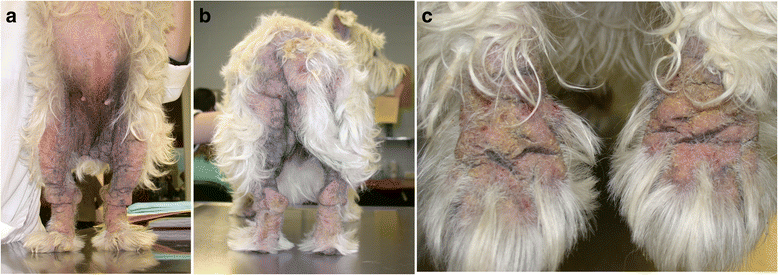Canine atopic dermatitis: detailed guidelines for diagnosis and allergen identification
- PMID: 26260508
- PMCID: PMC4531508
- DOI: 10.1186/s12917-015-0515-5
Canine atopic dermatitis: detailed guidelines for diagnosis and allergen identification
Abstract
Background: Canine atopic dermatitis (AD) is a common, genetically predisposed, inflammatory and pruritic skin disease. The variation in clinical presentations, due to genetic factors, extent of the lesions, stage of the disease, secondary infections, as well as resemblance to other non-atopic related skin diseases, can complicate a diagnosis of canine AD. A sub-group of the International Committee for Allergic Diseases in Animals (ICADA) was tasked with the development of a set of practical guidelines that can be used to assist practitioners and researchers in the diagnosis of canine AD. Online citation databases and abstracts from international meetings were searched for publications related to the topic, and combined with expert opinion where necessary. The final set of guidelines was approved by the entire ICADA committee.
Results: A total of 81 publications relevant for this review were identified. The guidelines generated focus on three aspects of the diagnostic approach: 1. Ruling out of other skin conditions with clinical signs resembling, or overlapping with canine AD. 2. Detailed interpretation of the historical and clinical features of patients affected by canine AD. 3. Allergy testing by intradermal versus allergen-specific IgE serum testing.
Conclusions: The diagnosis of canine AD is based on meeting clinical criteria and ruling out other possible causes with similar clinical signs. Flea combing, skin scraping and cytology should be performed, where necessary, as part of a thorough work-up. Elimination diet trials are required for patients with perennial pruritus and/or concurrent gastrointestinal signs. Once a clinical diagnosis of canine AD is made, allergy testing can be performed to identify potential causative allergens for allergen-specific immunotherapy.
Figures










References
Publication types
MeSH terms
Substances
LinkOut - more resources
Full Text Sources
Other Literature Sources

